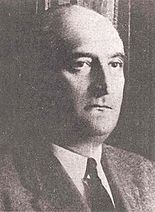Hugo Ehrlich facts for kids
Quick facts for kids
Hugo Ehrlich
|
|
|---|---|
 |
|
| Born | 31 January 1879 |
| Died | 21 September 1936 (aged 57) Zagreb, Kingdom of Yugoslavia
|
| Nationality | Croat |
| Alma mater | Vienna University of Technology |
| Relatives | Herman and Marija Ehrlich (parents) Mira Klobučar (sister) Marta Ehrlich (niece) |
Hugo Ehrlich (born January 31, 1879 – died September 21, 1936) was a famous Croatian architect. He designed many important buildings.
Contents
Early Life and Education
Hugo Ehrlich was born in Zagreb, which is now in Croatia. His family was wealthy. His father, Herman Ehrlich, was a builder and businessman. Hugo grew up with his brothers, Adolf, Ernest, Đuro, and his sister, Mira.
In 1897, Hugo started studying at the Vienna University of Technology. His brother Đuro had also studied there. Hugo learned from a famous architect named Carl König. He even worked in König's studio. After finishing university, Hugo stayed in Vienna for a while. He worked for another architect, Humbert Walcher.
Career Highlights
Hugo Ehrlich worked on many interesting projects. One of his first jobs was helping to restore a castle called Burg Kreuzenstein in Austria. In 1907, he worked on a new government building in his hometown of Zagreb.
From 1908 to 1912, Hugo helped to update a large house called Villa Karma in Switzerland. In 1909, he moved back to Zagreb. He joined his family's architecture studio.
Working with Viktor Kovačić
In 1910, Hugo Ehrlich teamed up with another architect, Viktor Kovačić. They formed their own studio called Kovačić & Ehrlich. They worked on several projects in Zagreb. These included designs for Jesuit Square and the Strossmayer Promenade. They also designed many homes and buildings together.
In 1914, Hugo had to join the Austro-Hungarian Army. He stopped working with Kovačić in 1915.
After World War I
After World War I, Hugo Ehrlich worked with his brothers, Adolf and Ernest. During this time, he designed buildings in a style called eclectic mannerism. This means he mixed different old styles together.
In the 1920s, Hugo designed more than twenty homes and business buildings. From 1921 to 1923, he worked on the Slavenska hipotekarna banka (Slavic Mortgage Bank) building.
Finishing the Stock Exchange
After Viktor Kovačić passed away in 1924, Hugo Ehrlich took over a big project. He helped finish the Zagreb Stock Exchange building. Today, this building is the Croatian National Bank. He worked with other architects, Alfred Albini and Stjepan Gomboš, to complete it in 1927.
Teaching and Studio Work
Starting in 1925, Hugo Ehrlich became a professor. He taught at the University of Zagreb's Faculty of Architecture. His studio became one of the biggest in Zagreb. Many talented young architects worked there. Some of them were Alfred Albini, Stephen Gomboš, and Drago Galić. In 1928, Hugo was invited to a special international meeting for architects.
Death
Hugo Ehrlich passed away in Zagreb on September 21, 1936. He was buried at the Mirogoj Cemetery.
Key Architectural Works
- Burg Kreuzenstein castle (restoration), Leobendorf, Austria.
- Villa Karma (restoration), Clarens, Switzerland.
- Residential and commercial buildings, Mihanovićeva street, Zagreb, Croatia.
- Residential and commercial building, Medulićeva street 2, Zagreb, Croatia.
- Residential and commercial building, Ilica 100, Zagreb, Croatia.
- Bauer residential house, Nazor street 6, Zagreb, Croatia.
- Rado residential house, Roko park 7, Zagreb, Croatia.
- Ehrlich residential house, Tuškanac, Zagreb, Croatia.
- Bank commercial building, Osijek, Croatia.
- Slavenska hipotekarna banka, Zagreb, Croatia.
- Zagreb Stock Exchange building, Zagreb, Croatia.
- Yugoslavian united bank, Belgrade, Serbia.
- Residential building, Varšavska street 2, Zagreb, Croatia.
- Palace Bombelles, Opatička street 4, Zagreb, Croatia.
- Residential and commercial building, Boškovićeva street 36, Zagreb, Croatia.
- Palace Janeković, Draškovićeva street 15, Zagreb, Croatia.


